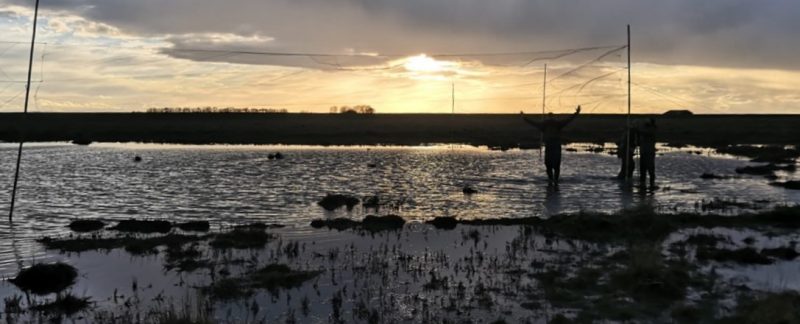Friday 24 March
Noble pioneers, Guy, Kirsty and Ryan joined the sunrise to recce a number of sites ahead of the main party. Ryan’s recce yielded more ducks and geese than waders at Gedney and Kirsty’s exploration of the beach at Snettisham was even more disappointing, with a dearth of birds. Thankfully, Guy, found flock of 230 Oystercatchers at Heacham South, 150 m south of the tump and another flock of 60 further south. However, Heacham South was busy with walkers and dogs and the Oystercatchers were very mobile as a result. The same could not be said of a flock of 500 Sanderling and 30 Turnstone at Heacham North North which demonstrated remarkable tolerance of disturbance and settled on a ridge on the beach for at least 40 minutes from 08:00 hrs, unwittingly identifying themselves as the best possible target for the following morning.
The forecast for the following morning was very changeable, but high winds seemed highly likely, so plans were developed to catch a sample of Turnstone and Sanderling higher up the beach away from the tide edge, to avoid the expected wave action.
After a team meeting in the evening with the majority of the party in attendance, alarms were set for 04:30 hrs in anticipation of an exciting morning at Heacham.
Saturday 25 March
Cannon-Netting for Sanderling
With a rather civilised hour for high tide, there was plenty of time to set up on the beach before the waders made their appearance. After some debate about whether to set one or two cannon nets, the team settled on just the one large mesh narrow net which was set high up on the beach to limit the possibility of a ‘wet catch’. The large mesh net was a necessity with expected high winds as a small mesh net is more affected by wind. Once set, positions were taken up at long stop and on the sea wall, whilst we waited for the arrival of our anticipated visitors.
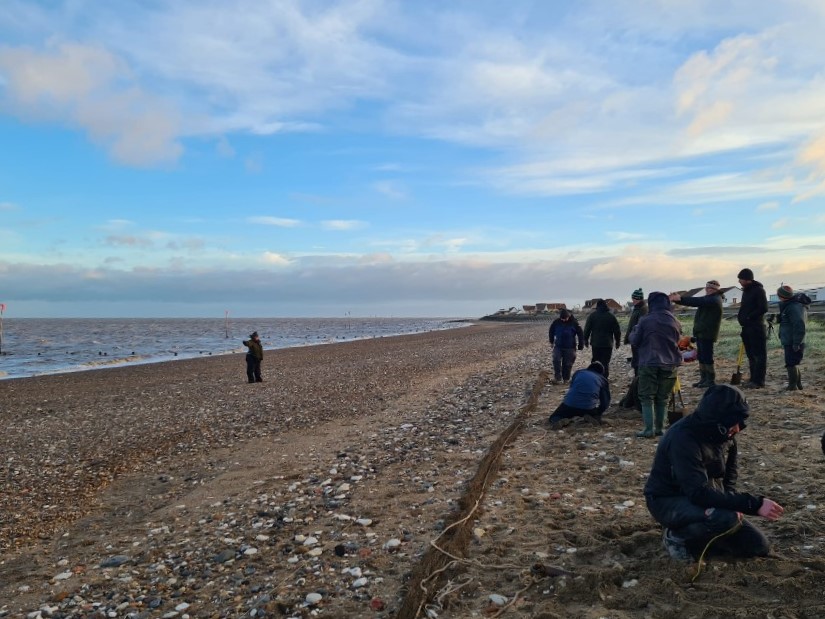
It wasn’t long before a small flock of Oystercatchers made an appearance at the north end of the beach, providing another set of spectators for the planned catch. Then, shimmering and susurrating Sanderlings made an appearance from the south, settling just above the shoreline away from the crashing waves – most sensible behaviour, but also helpful in that this was likely to lead to a dry catch. Pleasingly, a small group of Turnstone joined the flock. As before, during the recce, the birds were unperturbed by walkers and dogs on the sea wall and they edged slowly but surely up the beach as the tide advanced.
A promising start, but as ever, this was not destined to be straightforward. Having been stymied by dogs, paragliders and birds of prey before, we have got used to the best laid plans falling apart. On this occasion, a pair of Ringed Plovers arrived and presented an unusual complication. They had clearly decided that this would be a good place to think about raising a family – and we wish them every success in this endeavour – but please not today and not immediately in front of the net, where they could subvert any plan to fire. At one point, they engaged in an unashamed but short bout of copulation right in front of the net. As the Sanderlings edged further and further up the shore into the catching area, Richard was increasingly hopeful that the plovers would find another spot to express their ardent love for one another as they wandered back and forth in front of the net. A gentle jiggle sent the Sanderling flock wheeling off over the sea, with no impact on the (p)lovers. A moment of collective despair was swiftly assuaged by the returning Sanderlings who obliged by settling back on the beach in the catching area and once the plovers had finally moved into a safe spot, the net was fired at 08:12 hrs. We caught about half of the flock and the team set to work extracting Sanderlings from the large mesh net, but with effective teamwork, we were ready to start processing just over an hour later. We set up on the leeward side of the beach house to escape the chilling wind.
The catch was dominated by Sanderling, as planned, but we also caught a nice sample of Turnstone and a Knot which could be colour-marked for later re-sightings, as well as two Dunlin and the amorous Ringed Plovers. The value of colour-marking was evidenced by one of the Sanderling (NT87739) which had been ringed on 18 April 2007 and re-sighted on 102 subsequent occasions, before being recaptured almost 16 years later. An old bird, but not quite a record breaker, as the current record (age from ringing) stands at 17 years, 7 months and 3 days which was set in 1988 (also ringed and recaptured by WWRG). It will be worth looking out for this bird in future years as it stands a good chance of beating that record and it’s certainly smashed the average life expectancy for a Sanderling which is just 7 years.
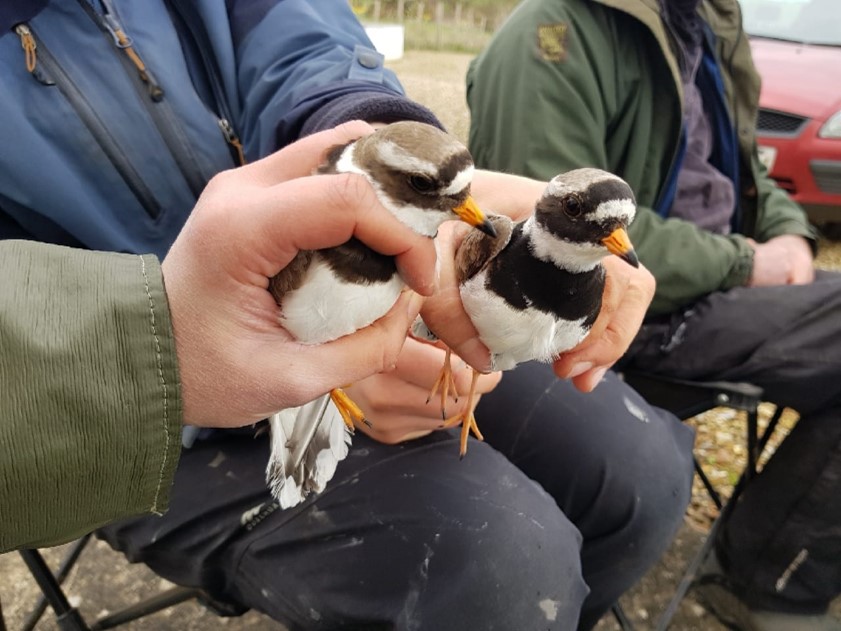
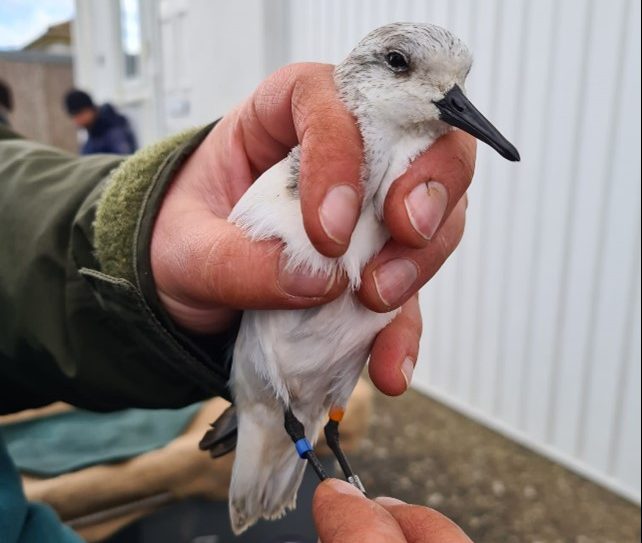
The anticipated showers arrived whilst birds were being processed, but they were brief and only a minor inconvenience, with all of the birds processed and released by 12.10 hrs – the perfect time to head back to the base for breakfast and a large pot of coffee. It had been a very satisfying morning, with a good catch and some useful data to add to the records. The Sanderling will soon be heading off to their breeding grounds in the high Arctic, leaving the Ringed Plovers on the beach in some peace to raise the next generation.
Catch summary from Heacham NN
| Species | New | Retrap | Total |
| Ringed Plover | 1 | 1 | 2 |
| Sanderling | 169 | 74 | 243 |
| Dunlin | 2 | 0 | 2 |
| Turnstone | 4 | 1 | 5 |
| Knot | 1 | 0 | 1 |
| Totals | 177 | 76 | 253 |
Mist-Netting on Terrington Pools
After a hearty breakfast, planning in earnest could begin for the evening session. The tide had ‘made’ by quite a margin earlier in the day (rising to a greater height than predicted) and this seemed likely in the evening given the low pressure system settling over the Wash. The outer pools at Terrington would be deep underwater very quickly, but the inner pools presented a realistic option for mist netting on the high tide. Two teams set out in the afternoon to set a total of 18 nets across white barn pool and the cannon-net pool, whilst Lucy and a small team of sous-chefs created enough curry to feed the team for several days if necessary! Drawn by the smell of curry and the prospect of more adventures on The Wash we were joined by our VIPs, Jacquie and Nigel, with everyone assembling at the base to eat and head off again at 19:00 hrs.
After such a blustery morning, it was remarkable to find that the wind had dropped so much and the night sky was clear, with a full array of constellations on show and a number of passing satellites to keep us entertained whilst waiting for the waders to arrive at the pools.
One of the first birds to find the nets at the white barn pool was a Shelduck, which was never part of the plan but a welcome addition nonetheless. As the night progressed, birds were drawn to the lures, but in relatively small numbers, which provided opportunities for less-experienced members of the team to hone their extraction skills without the same level of urgency required with a bigger catch – always an upside at The Wash! The overall catch was small but a good range of species was represented, including Oystercatcher, Redshank, Bar-tailed Godwit, Dunlin and a Grey Plover. The latter was another old bird for the trip, having been ringed in 2004. It is not threatening the longevity record yet (25 years, 1 month and 18 days) but it’s on the way.
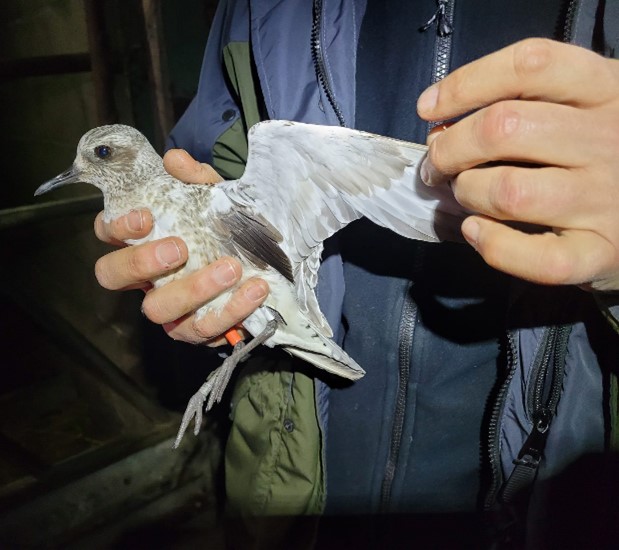
The ringing team were joined by a herd of cattle in the white barn shed who watched with interest as the waders and the bonus Shelduck were processed by the teams.
Catch summary from Terrington Inner Pools
| Species | New | Retrap | Total |
| Oystercatcher | 2 | 0 | 2 |
| Redshank | 15 | 1 | 16 |
| Dunlin | 42 | 1 | 43 |
| Bar-tailed Godwit | 2 | 0 | 2 |
| Grey Plover | 0 | 1 | 1 |
| Totals | 61 | 3 | 64 |
| Shelduck | 1 | 0 | 1 |
We were back at the base just after midnight and after a debriefing, there was a little time for a few celebratory drinks, having secured two decent catches on one day. 1 am soon became 2 am (the clocks went forward), but we could afford a late night because high tide on Sunday was quite a lot later!
Sunday 26 March
The following day was a quieter affair. After breakfast, curry for some (!), there was a need to sort out and dry the equipment used on the previous day. A few hardy souls set off to capture more data, with resighting trips planned to the Curlew fields, Heacham North and Snettisham Pits. A good sample of data was drawn together and capped off another fine weekend in wonderful company in a very special part of the world.
Colour-mark Re-sighting Totals
| Species | Total Sightings | Individuals | WWRG | Non-WWRG |
| Bar-tailed Godwit | 13 | 10 | 13 | 0 |
| Turnstone | 7 | 6 | 7 | 0 |
| Curlew | 65 | 54 | 59 | 6 |
| Knot | 4 | 4 | 0 | 4 |
| Avocet | 2 | 2 | 0 | 2 |
| Sanderling | 1 | 1 | 0 | 1 |
| Grey Plover | 2 | 2 | 2 | 0 |
| Total | 94 | 79 | 81 | 13 |
Here are a few interesting observations:
Curlew: Four individual headstarted Curlew seen, three on the Heacham caravan field and one on Heacham NN mudflats
Grey Plover: Two WWRG birds (one last sighted in May 2022 and the other in December 2021).
Avocet: Two birds ringed in France and seen on The Wash in several previous years in spring/summer, one as far back as 2015.
Knot: We were surprised to find 10,000+ Knot roosting on Snettisham pits on the 24th, possibly due to the tide surge the previous day. Three of the resighted Knot had been colour-marked on Merseyside and the fourth in NW Iceland. Two members of WWRG were part of the team that caught the Knot ringed in Iceland in May 2022 where it was staging on its way north to the breeding grounds in Greenland/Canada.
Trip Ringing totals – The Grand Total for the trip
| Species | New | Retrap | Total |
| Ringed Plover | 1 | 1 | 2 |
| Sanderling | 169 | 74 | 243 |
| Turnstone | 4 | 1 | 5 |
| Knot | 1 | 0 | 1 |
| Oystercatcher | 2 | 0 | 2 |
| Redshank | 15 | 1 | 16 |
| Dunlin | 44 | 1 | 45 |
| Bar-tailed Godwit | 2 | 0 | 2 |
| Grey Plover | 0 | 1 | 1 |
| Total Waders | 238 | 79 | 317 |
| Shelduck | 1 | 0 | 1 |
| Grand Total | 239 | 79 | 318 |
Thanks to Ian Cooksey for writing this report. Cover photo by Molly Brown.

